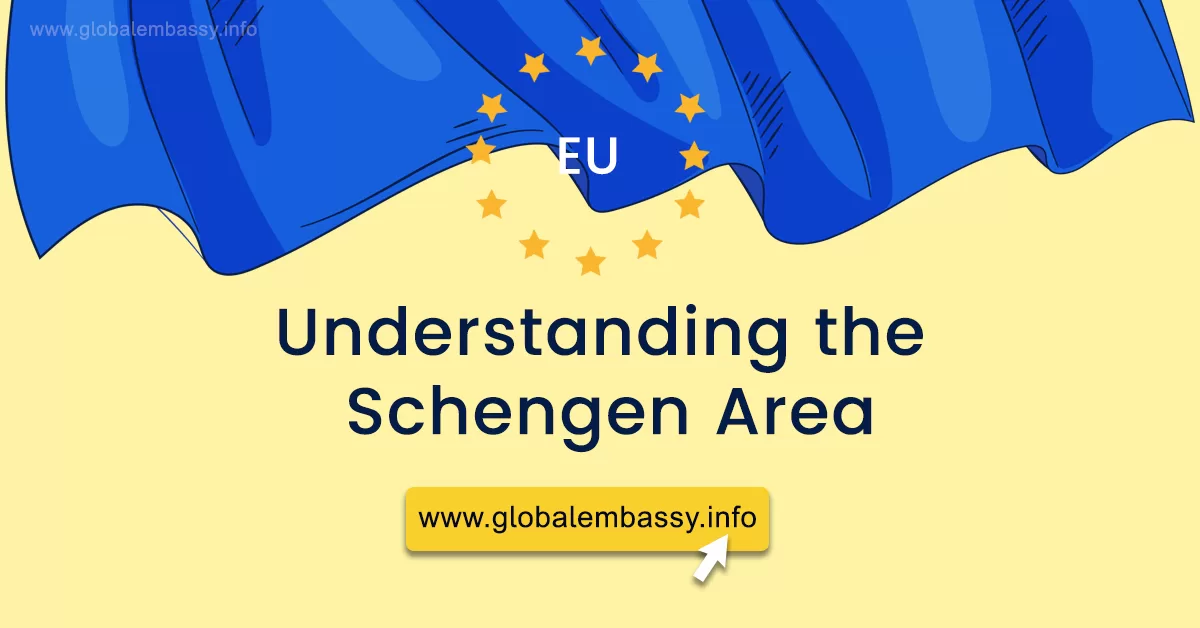The Schengen Area is a zone in Europe comprising 29 countries that have abolished border controls at their mutual borders, allowing for unrestricted movement of people.
It is one of the largest visa-free travel areas in the world, promoting economic, social, and cultural integration among its member states.

More Resources:
History of the Schengen Area
The Schengen Area was established by the Schengen Agreement, signed in the village of Schengen, Luxembourg, in 1985.
Initially, the agreement involved five countries (Belgium, France, Germany, Luxembourg, and the Netherlands) and aimed to create a common travel area without internal borders.
Over the years, the Schengen Agreement was incorporated into European Union law, and the zone expanded to include 29 countries.
Member Countries in Schengen Area
The Schengen Area includes 23 European Union (EU) member states and 4 non-EU members:
EU Members in the Schengen Area:
- Austria
- Belgium
- Czech Republic
- Denmark
- Estonia
- Finland
- France
- Germany
- Greece
- Hungary
- Italy
- Latvia
- Lithuania
- Luxembourg
- Malta
- Netherlands
- Poland
- Portugal
- Slovakia
- Slovenia
- Spain
- Sweden
Non-EU Members:
- Iceland
- Liechtenstein
- Norway
- Switzerland
Special Cases:
- Monaco, San Marino, and Vatican City are de facto part of the Schengen Area due to open borders with neighboring member states.
Purpose and Goals
The primary objectives of the Schengen Area are:
- Facilitating Free Movement: Travelers can move across borders without the need for passport checks.
- Enhancing Cooperation: Countries share security, policing, and immigration data to ensure safety while promoting freedom of movement.
- Boosting Tourism and Trade: By removing barriers, the Schengen Area encourages tourism, cross-border trade, and economic growth.
Traveling Within the Schengen Area
Once you enter a Schengen country, you can travel freely to other member states without border checks. However, travelers must carry valid identification, such as a passport or national ID card, as random checks may occur.
Who Can Enter the Schengen Area?
Visa-Free Travelers
Citizens from certain countries (e.g., the US, Canada, Japan, Australia) can enter the Schengen Area without a visa for up to 90 days within a 180-day period.
Such travelers will need to apply for an ETIAS authorization (European Travel Information and Authorization System).
Visa-Required Travelers
Citizens of non-Schengen and non-visa-exempt countries must apply for a Schengen Visa to enter the zone. The visa allows travel for tourism, business, or short stays within the same 90-day limit.
How Does the Schengen Visa Work?
The Schengen Visa grants entry to all member countries. For example, if you obtain a visa from France, you can travel to any other Schengen country during your visit.
However, travelers are advised to apply for a visa from the country where they will spend the most time or the country of first entry.
Security and Border Management
Although internal borders have been abolished, the Schengen Area implements strict external border controls.
Member countries collaborate through agencies like Frontex (European Border and Coast Guard Agency) and share information via the Schengen Information System (SIS) to enhance security and combat illegal activities.
Advantages of the Schengen Area
- Ease of Travel: Tourists, business professionals, and residents enjoy seamless travel across member states.
- Boost to Tourism: Countries in the Schengen Area attract millions of international tourists annually.
- Economic Integration: The removal of borders facilitates trade and labor mobility.
- Enhanced Security Cooperation: Sharing intelligence ensures collective safety.
Challenges and Criticisms in Schengen Area
While the Schengen Area offers significant benefits, it also faces challenges:
- Migration and Refugee Crises: Pressure on external borders can strain member countries.
- Security Threats: Free movement can pose risks, such as cross-border crime and terrorism.
- Temporary Border Controls: In emergencies (e.g., pandemics or large-scale events), some countries may reinstate border checks temporarily.
Conclusion
The Schengen Area stands as a symbol of unity, freedom, and collaboration in Europe. By eliminating internal borders and fostering cooperation, it has created a region where travel and commerce flourish.
Whether you’re a tourist exploring iconic cities or a business traveler attending meetings, the Schengen Area simplifies and enhances the European experience.
As it continues to evolve, the Schengen Area remains a cornerstone of European integration and a model for international cooperation.
FAQs
Can I work in the Schengen Area with a Schengen Visa?
No, the Schengen Visa only permits tourism, business, or family visits. You need a work visa or residence permit to work.
What happens if I overstay my Schengen Visa?
Overstaying can result in fines, deportation, or bans on re-entry.
Are all EU countries part of the Schengen Area?
No, countries like Ireland and Cyprus are EU members but not part of the Schengen Area.
Tips for Traveling in the Schengen Area
- Check Visa Requirements: Ensure your visa covers your intended travel dates.
- Carry Identification: While border checks are removed, you must carry a valid ID or passport.
- Understand Local Laws: Each country has unique regulations despite being part of the Schengen Area.
The Schengen Area remains a cornerstone of European mobility and cooperation. Understanding its regulations and benefits can help travelers and residents make the most of their time in Europe.